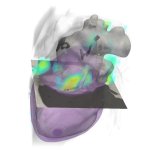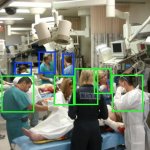
News • Potential risks
Mobile apps have serious problems with privacy
An in-depth analysis of more than 20,000 health related mobile applications (mhealth apps) finds “serious problems with privacy and inconsistent privacy practices.”

An in-depth analysis of more than 20,000 health related mobile applications (mhealth apps) finds “serious problems with privacy and inconsistent privacy practices.”

Digital transformation has been a significant factor in the way hospitals have responded to the challenges posed by the COVID-19 pandemic. However, at HIMSS21 European Health Conference, experts were also quick to point out that the approach of the ‘human resource’ to the challenges and changes was a key factor.

New artificial intelligence (AI) technology to scan for heightened blood vessel inflammation can calculate a person’s risk of death from Covid-19 and its variants.

A new platform allows hospitals to deliver improved organisational and financial performance by deploying an Internet of Things (IoT) sensor network to collect data and using AI to analyse the gathered information in a HIPAA-compliant way.

Communities benefit from sharing knowledge and experience among their members. Following a similar principle - called “swarm learning” - an international research team has trained artificial intelligence algorithms to detect blood cancer, lung diseases and Covid-19 in data stored in a decentralized fashion. This approach has advantage over conventional methods since it inherently provides…

26 May 2021 marks the Date of Application of the European Medical Device Regulation (MDR). Replacing the Medical Devices and Active Implantable Medical Devices Directives, the Regulation is a welcome update for patient safety, transparency, and access to medical devices for Europeans. COCIR has been contributing to the development and implementation of the MDR since the very first discussions in…

Physicians are increasingly using software to automatically evaluate Holter ECG signals in adult patients, but so far, no software has been developed for children. Cardiomatics and the Medical University of Warsaw are on the way to a breakthrough in paediatric cardiology. They are developing an international tool for automatic assessment, analysis, and interpretation of electrocardiographic…

Heart disease and cancer are the leading causes of death in the United States, and it’s increasingly understood that they share common risk factors, including tobacco use, diet, blood pressure, and obesity. Thus, a diagnostic tool that could screen for cardiovascular disease while a patient is already being screened for cancer has the potential to expedite a diagnosis, accelerate treatment, and…

Artificial Intelligence in health and care is being introduced across the UK via a major national project that is already producing a range of innovations. Latest developments were outlined to the online Intelligent Health conference in a headlining presentation by Dr Indra Joshi, Director of AI at NHSX, which is a joint unit bringing together teams from NHS England and NHS Improvement, and the…

Activity monitors via phones and bracelets help to assess exercise but experts question which device may really stimulate activity in cardiovascular patients, and which might be best for research?

A branch of artificial intelligence (AI), called machine learning, can accurately predict the risk of an out of hospital cardiac arrest--when the heart suddenly stops beating--using a combination of timing and weather data, finds research published online in the journal Heart. Machine learning is the study of computer algorithms, and based on the idea that systems can learn from data and identify…

Computer scientists at the University of California San Diego have developed a more accurate navigation system that will allow robots to better negotiate busy clinical environments in general and emergency departments more specifically. The researchers have also developed a dataset of open source videos to help train robotic navigation systems in the future. The team, led by Professor Laurel Riek…

The majority of top-rated fertility apps collect and even share intimate information without the users’ knowledge or permission, a collaborative study by Newcastle and Umea Universities has found. Researchers are now calling for a tightening of the categorisation of these apps by platforms to protect women from intimate and deeply personal information being exploited and sold.

CliniSys Group aims to help healthcare professionals test, diagnose and treat millions of patients every day, saving or improving quality of life, the company reports. "CliniSys is a trusted partner to hospitals and private healthcare organisations across Europe. We routinely provide reliable, intuitive diagnostics solutions that help healthcare professionals spend more time focusing on…

A new research project will embrace the combination of 5G telecommunications technology and AI to offer continuous remote monitoring to seriously ill heart failure patients, for example those with Left Ventricular Assist Devices (LVADs).

Kobe University Hospital’s Dr. Makoto Nishimori and Project Assistant Professor Kunihiko Kiuchi et al. (of the Division of Cardiovascular Medicine, Department of Internal Medicine) have developed an AI that uses multiple kinds of test data to predict the location of surplus pathways in the heart called ‘accessory pathways’, which cause the heart to beat irregularly. In this study, the…

In just the last two years, artificial intelligence has become embedded in scores of medical devices that offer advice to ER doctors, cardiologists, oncologists, and countless other health care providers. But how much do either regulators or doctors really know about the accuracy of these tools? A new study led by researchers at Stanford, some of whom are themselves developing devices, suggests…

Every year, millions of children around the world are admitted to hospital for having anaesthesia and surgery. Many of them experience preoperative anxiety which negatively affects both their hospital experience and medical outcome, as well as their future relationships with healthcare services from both a short-term and long-term point of view. A new, internationally aimed website offers…

Over the past decade, hospitals and other healthcare providers have put massive amounts of time and energy into adopting electronic healthcare records, turning hastily scribbled doctors' notes into durable sources of information. But collecting these data is less than half the battle. It can take even more time and effort to turn these records into actual insights — ones that use the learnings…

The U.S. Food and Drug Administration authorized marketing of the GI Genius, the first device that uses artificial intelligence (AI) based on machine learning to assist clinicians in detecting lesions (such as polyps or suspected tumors) in the colon in real time during a colonoscopy. “Artificial intelligence has the potential to transform health care to better assist health care providers and…

Legal challenges hamper the sharing of health data with researchers outside the EU/European Economic Area (EEA), a new report by European academy networks concludes. The authors call for solutions to overcome these barriers to ensure timely and straightforward research collaboration in the public sector and thereby maximize health benefits for European citizens.

Accessible and affordable healthcare is one of the topics of Healthcare Automation and Digitalization Congress. It will take place in Zurich, Switzerland on the 27th - 28th of September, 2021. At the Congress, top-management from healthcare providers and pharmaceutical companies, healthcare professionals, IT managers, and heads from technology companies will discuss the developing ways of the…

A Japanese research group combined motion analysis that uses smartphone application and machine learning that uses an anomaly detection method, thereby developing a technique to easily screen for carpal tunnel syndrome. Carpal tunnel syndrome is common amongst middle-aged women. The disease causes compressed nerves in the wrist, causing numbness and difficulty with finger movements. While an…

The U.S. Food and Drug Administration approved the first in the world non-surgical heart valve to treat pediatric and adult patients with a native or surgically-repaired right ventricular outflow tract (RVOT). The device, called the Harmony Transcatheter Pulmonary Valve (TPV) System, is intended to improve blood flow to the lungs in patients with severe pulmonary valve regurgitation without…

Healthy and cancer cells can look similar under a microscope. One way of differentiating them is by examining the level of acidity, or pH level, inside the cells. Tapping on this distinguishing characteristic, a research team from the National University of Singapore (NUS) has developed a technique that uses artificial intelligence (AI) to determine whether a single cell is healthy or cancerous…